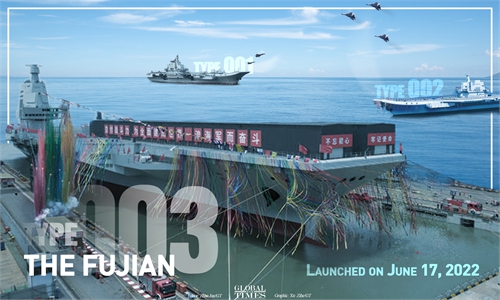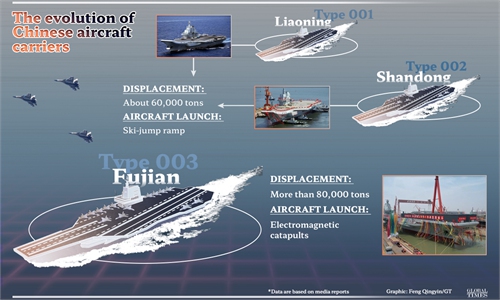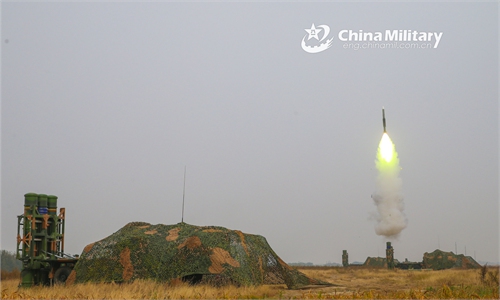IN-DEPTH / IN-DEPTH
Harvest time for China’s aircraft carrier development through a century’s waves
Victorious voyage
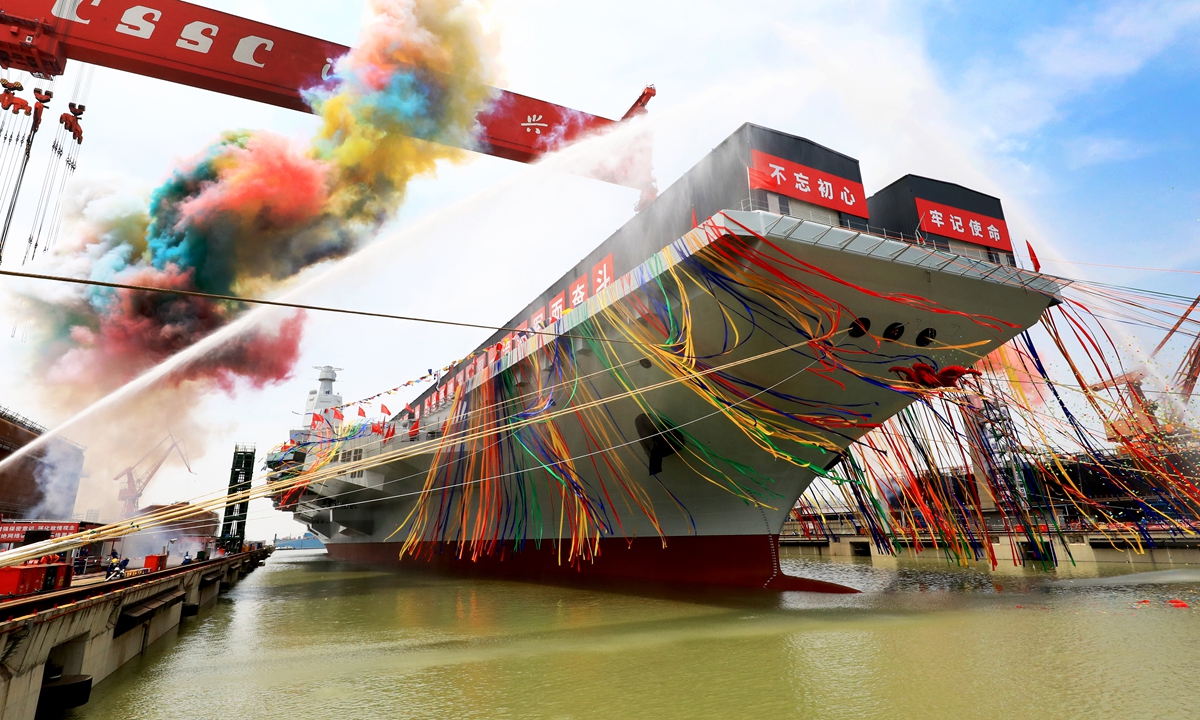
China's third aircraft carrier, the Fujian, is launched in Shanghai on June 17, 2022. Photo: VCG
On June 17, China launched its third aircraft carrier, the Fujian. The 80,000 ton-class heavy vessel is also the country's second domestically developed carrier and the first one in China equipped with electromagnetic catapults and arresting devices, greatly narrowing the technological gap with its US counterparts. The Chinese People's Liberation Army (PLA) Navy had no aircraft carrier 10 years ago, and the launch of the Fujian reflects just how fast China's aircraft carrier program has developed and the big strides made by the PLA Navy.No aircraft carrier could come into being without a country's comprehensive national strength. The Chinese people dreamed of aircraft carriers many decades ago, and China's aircraft carrier program was launched but later halted multiple times. With bitter, tearful stories from some of the country's well-known military officers, the country's achievement in aircraft carrier development today is a hard-earned victory.
Realizing a dream
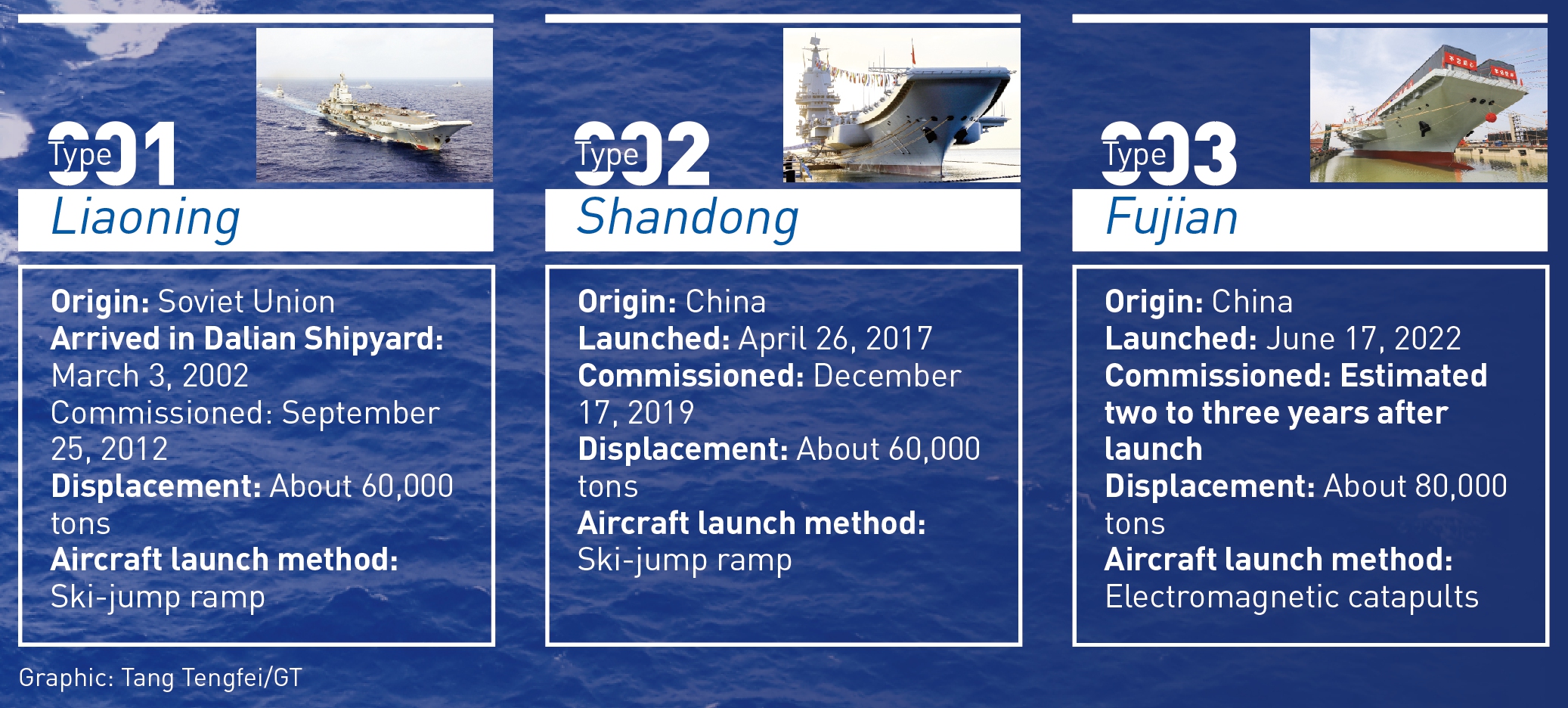
Graphic: GT
For the first time in history, the US successfully experimented with aircraft takeoff and landing on cruisers in the early 1910s. Aircraft carrier also made an appearance in the First World War and transformed naval warfare into multidimensional undertaking. China was extremely weak at that time, but visionaries of the time understood the importance of this new, epoch-making weapon, according to Chinese military experts.Chen Shaokuan, minister of the navy during the Republic of China era, was one of the first to suggest that China should have an aircraft carrier. He said in as early as 1932 that China should operate at least 20 aircraft carriers to safeguard the country from the Japanese aggression. But this plan was impossible to realize, as purchasing these ships alone cost three times the annual financial revenue of the national government at that time, so Chen raised this idea only to highlight the importance of aircraft carriers to the government. In the War of Resistance against Japanese Aggression (1931-45), all Chinese warships, outdated even at their time, capsized.
After the victory against the Japanese invaders in 1945, Chen again planned to acquire 12 aircraft carriers in 30 years. But to Kuomintang Chairman Chiang Kai-shek who was in a hurry attempting to eliminate the Communist Party of China (CPC) in land combat, this plan was out of the question, not to mention China's shipbuilding industry at the time could only build hundred ton-class small vessels and had to rely on imports to get engines.
After the founding of the People's Republic of China in 1949 and facing a maritime blockade from the world's superpower the US, the PLA Navy opted for a long-term development focus on land-based naval aviation, submarine, and fast boat forces given very limited defense budgets and the idea of maritime guerrilla warfare.
As jet aircrafts began to board aircraft carriers in the 1950s, the technological requirements and cost needed to build an aircraft carrier skyrocketed, and only the US was able to operate this type of vessel. The Soviet Union only began to build such vessels in the 1970s.
Under these straitened circumstances, Chairman Mao Zedong said at a meeting of the Central Military Commission (CMC) in June 1958 that China should build aircraft carriers and develop far sea fleets. The PLA Navy planned to build an aircraft carrier in the early 1960s. But the harsh reality on the ground at the time demonstrated that China's poverty and lack of technology could not be changed in a short time, and the plan to build 600,000 tons of warships was scrapped only a year after it was raised.
In the 1970s, China's economic strength and subsequently its shipbuilding industry saw significant improvement, and overseas trade became increasingly important to the country's development, so safeguarding remote islands and sea lanes went on agendas. The PLA won the battle of the Xisha Islands with small boats against South Vietnam's large vessels in January 1974, but exposed its own weakness of lack of aerial support. When the South Vietnamese regime fell in 1975, the PLA Navy failed to seize the opportunity to retrieve the six Nansha islets, and the Democratic Republic of Vietnam claimed so-called sovereignty over said islands in the South China Sea. These missed opportunities showed that only naval strength can decide the actual control of remote islands, which compelled China to pay attention to the development of its maritime forces.
Seriously ill, Mao still approved a plan to build 700,000 tons of warships for the PLA Navy in 1975, as leaders of the Navy, again, planned an aircraft carrier project, despite the lingering challenges in funding and technology. In 1978, then Central Military Commission Chairman Hua Guofeng approved the purchase from or joint building of an 18,000 ton-class light carrier with the UK for the PLA Navy, equipping it with UK Harrier vertical takeoff and landing fighter jets. In the early 1980s, China and the UK held negotiations over the project, but the quoted price from the UK was exorbitant for China, which soon shifted its focus to economic development, slashing defense spending and again canceling its aircraft carrier program.
In 1980, when Liu Huaqing, the former vice chairman of the CMC, later dubbed father of Chinese aircraft carriers, boarded a US aircraft carrier, he stood on his toes to get a better view of the US' technological advancements. This moment was caught on camera, and Liu's move in the hope of one day building an aircraft carrier of China's own later deeply moved the hearts of Chinese people.
But at that time, many people within China did not understand the importance of the navy, not to mention aircraft carriers. Liu instructed Zhang Zhaozhong, a retired military expert at the PLA National Defense University, who had conducted research on aircraft carriers for many years, to promote aircraft carriers to other departments, but this proposal was not well received, as there was not enough money available to build aircraft carriers.
Zhang recalled in a TV program in 2017 that when he reported back to Liu on the situation, Liu sadly acknowledged that the idea of a Chinese aircraft carrier was not supported by many, even among the Chinese public. The military budgets for the PLA lagged behind those of the US, Russia, India, Japan, and even the island of Taiwan. The navy is a money-consuming military service, making it virtually impossible for PLA to build a proper frigate at the time, Zhang said.
China's economic reality at the time could not support naval development, leading to a Vietnamese-led occupation of a number of Chinese islands, Zhang said.
China emerged victorious against Vietnam in the Chigua Reef Skirmish on March 14, 1988 in the Nansha Islands, but despite this victory, weaknesses were exposed in the lack of air support once again. At the time, China's southernmost airfield was 1,000 kilometers away from the Nansha Islands, while the country's fighter jets only possessed a 400-kilometer combat radius. After the skirmish, the PLA Navy again urged for the building of aircraft carriers. Liu, as naval chief, planned to conduct a pre-study of aircraft carriers from 1991 to 1995, and started development work in 2000. But China's economy was still not strong enough, and the defense budget in 1990 was only about $5 billion, ranking below the top 10 in the world, so the program was initially limited to only the pre-study phase.
China purchased the decommissioned UK-made HMAS Melbourne light carrier from Australia in 1985, then acquired ex-Soviet carriers Minsk and Kiev. The studies on these carriers more or less contributed to China's aircraft carrier program, but it was the ex-Soviet carrier Varyag that was refitted into its first aircraft carrier by China
As China embarked on its rapid economic growth period in the 1990s and the start of the 21st century, conditions were finally perfect for the increase of national defense investments. It has become a domestic consensus at this time that a major country with overseas interests must have aircraft carriers.
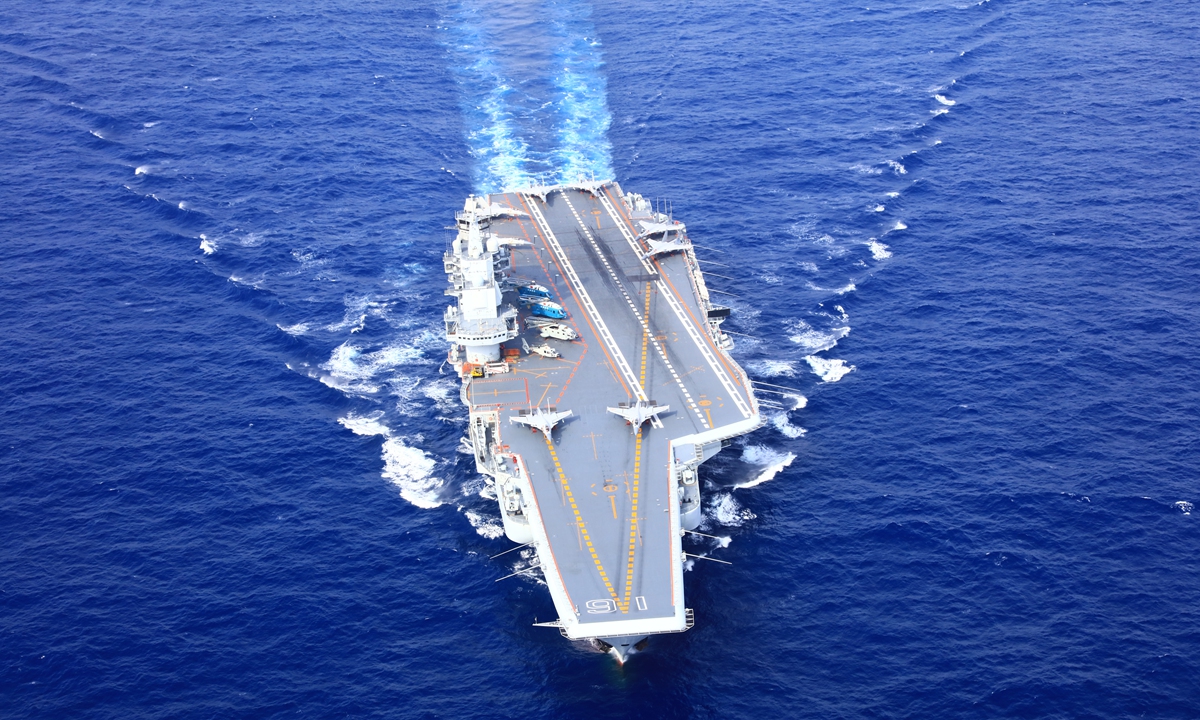
The first Chinese aircraft carrier, the Liaoning, at sea. Photo: VCG
In 1999, entrepreneur Xu Zengping purchased the unfinished Varyag from Ukraine. Because of US pressure on Turkey to stop the ship from leaving, the Varyag stayed in Ukraine for two more years until Turkey allowed it to pass through the Bosporus Strait in November 2001 after China's diplomatic efforts with Turkey. After a four-month voyage, the carrier arrived in Dalian, and Xu decided to hand it over to the PLA.It saved China a lot of time and cost to learn the construction of an aircraft carrier to refit one based on the Varyag than building one from scratch. The refitted carrier made its first sea trial voyage on August 10, 2011, and after a series of tests, it was renamed the Liaoning and commissioned for use by the PLA Navy on September 25, 2012, when China, for the first time, had an operational aircraft carrier.
Backed by national strength
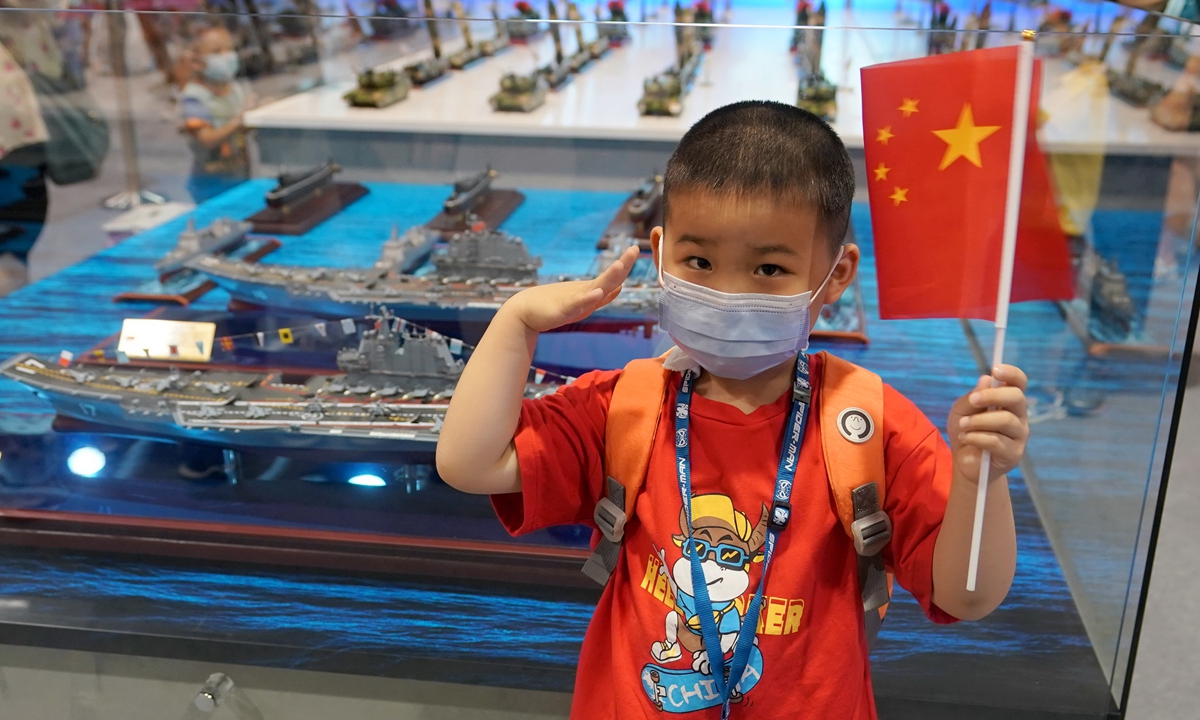
A child salutes in front of the Liaoning and Shandong models at the Hong Kong Convention and Exhibition Center on July 3, 2021. Photo: IC
An aircraft carrier is a large and complex system that involves almost all industries including shipbuilding, electronics, engines, aviation, aerospace, and the sourcing of materials, and represents a country's overall technological and industrial capacities and comprehensive national strength, military experts told the Global Times.The Varyag came to China as practically an empty shell, and China rebirthed it as the Liaoning with full propulsion systems, weapons, electronics, and radars among others, plus carrier-based fighter jets. With accumulated experiences in refitting the Liaoning, China then independently designed and built the country's first domestically developed aircraft carrier and the second one overall, the Shandong, which is based on the Liaoning but with many improvements. It was launched on April 26, 2017 and entered PLA Navy service on December 17, 2019, as China entered a dual carrier era.
But both the Liaoning and the Shandong are of an outdated Soviet configuration with a ski-jump ramp, and their combat capabilities trail behind those of US super carriers that use catapults. On June 17, 2022, the Fujian, China's third aircraft carrier, was launched, leaving the world in wonder, as China has now independently developed its own aircraft carrier that comes close to its US counterparts by having similar displacement and electromagnetic catapults. It is also expected that China will eventually develop even larger, nuclear-powered aircraft carriers. No country without a high comprehensive national strength can make these achievements, experts said.
Looking back on the path China's aircraft carrier program has taken, for those who dreamed of Chinese aircraft carriers, devoted their lives to them, and did not live long enough to see their efforts come to fruition, China can now proudly remember and commemorate them with hard-earned achievements in the country's aircraft carrier development today.

